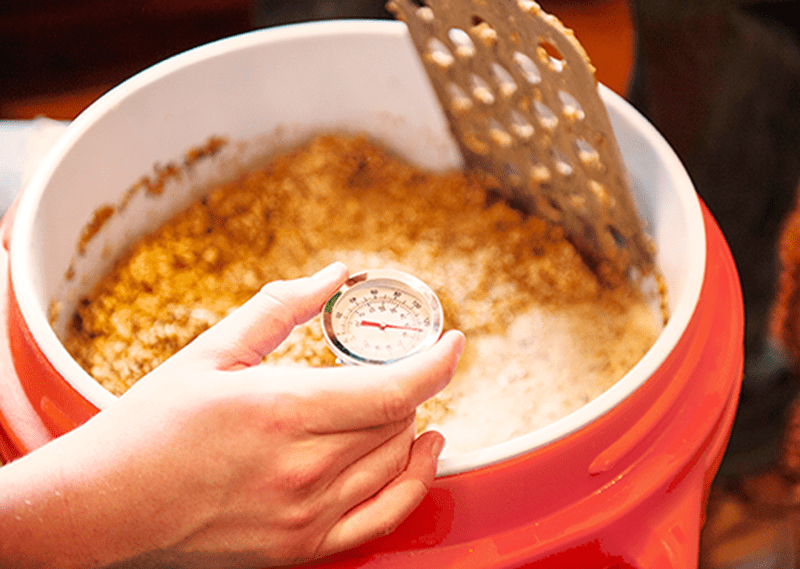 On a basic level, mashing is a very straightforward part of homebrewing: simply soak the crushed grains in hot (146-160˚F) water for an hour to extract the fermentable sugars. Occasionally though, a homebrewer may want to employ a protein rest, a short mash step at a lower temperature before raising it to the normal range. Here is some additional information on this topic, including how to do a protein rest.
On a basic level, mashing is a very straightforward part of homebrewing: simply soak the crushed grains in hot (146-160˚F) water for an hour to extract the fermentable sugars. Occasionally though, a homebrewer may want to employ a protein rest, a short mash step at a lower temperature before raising it to the normal range. Here is some additional information on this topic, including how to do a protein rest.
What is a protein rest? When and why should you do it?
A protein rest is a short mash at 113-131˚F used to activate certain enzymes in the malted grains that break down protein chains. The homebrewer will simply mash in at a lower temperature than usual do the protein rest. As to how long to do a protein rest, it’s usually only about 15-30 minutes. After that the temperature is then raised to the normal mash temperature (also known as the saccharification rest).
Why break down protein in the beer? Randy Mosher explains:
“At 113-131˚F, proteolytic enzymes chop up some of the long protein molecules into smaller chunks. The length of a protein (or fragment) determines whether it will contribute to the body of a beer, aid in head formation and head retention, or simply be a nuisance as a haze former when the beer is chilled.”
Mosher goes on to say that in most cases, modern malts do not need a protein rest. In fact, John Palmer points out that “using a protein rest on fully modified malts tends to remove most of the body of a beer, leaving it thin and watery.” But if you experience issues like chill haze, it may be worth doing.
Are there certain styles of beer that deserve a protein rest?
 As a matter of fact, yes. Most of your homebrews will probably not need a protein rest, but there are a few exceptions:
As a matter of fact, yes. Most of your homebrews will probably not need a protein rest, but there are a few exceptions:
- Those that use less-modified malt.
- Traditional styles such as a traditional American lager or Munich Dunkel.
- When decoction mashing.
- When using a high proportion of unmalted grain. (25% or more)
Since most malts on the market these days are well-modified, you may never need to do a protein rest. But if attempting to brew a style authentically, a protein rest may be in order.
How to Do a Protein Rest
If you have a heated mash tun, doing a protein rest is easy. Simply raise the temperature mash from step to step. This is called a step mash.
If you use a mash tun cooler, a protein rest is a little more tricky. How to raise the mash temperature from the protein rest to the saccharification rest? The best way is to divide your mash water. Use about half of it for the protein rest, then heat the remaining water and add it in to raise the overall temperature of the mash to the target saccharification temperature. This is called a decoction mash.
Calculating the appropriate temperatures can be a challenge. I recommend using some brewing software to help with the calculations, but here’s an example from a batch I’m brewing this week. This should giving you a little better understanding of how to do a protein rest:
Target protein rest temp: 122˚F
Target saccharification rest temp: 154˚F
Pre-boil volume: 6.75 gallons
Mash procedure:
- Dough in using 11.5 qts water at 148˚F. Hold at 122˚F for 15 minutes.

- Add 10 qts. water at 190˚F to raise temperature to 154˚F. Hold for 60 minutes.
- Add 10 qts. water at 207.5˚F to raise temperature to 168˚F for mash out. Hold for 10 minutes.
- Sparge with approx. 5 qts. water at 170˚F to collect about 6.75 gallons of wort.
The exact numbers will depend on your equipment and your beer recipe, but this should give you a good idea of how to incorporate a protein rest into your homebrew procedure.
Whether you’re a homebrewer that uses a step mash or decoction mash, doing a protein rest can be a great way to add a different dimension to you brews. How long should the protein rest be? At what temperature should the protein rest be at? These are all questions for you to answer. Just take good notes and follow the guidelines laid out here and you’ll do fine.
—–
David Ackley is a beer writer, brewer, and self-described “craft beer crusader.” He holds a General Certificate in Brewing from the Institute of Brewing and Distilling and is founder of the Local Beer Blog.

Hi David,
I was wondering if you could help clear something up for me. I’ve been reading about protein rests, and have run into this contradiction regarding the points about it making thin and watery beer (some also citing poor head retention), but also being appropriate for decoction mashing. To me, it sounds like it will help reduce chill haze, and help lautering if using a lots of flaked grains. But why is it also okay in the decoction mash context? I would appreciate any comments / clarification you can provide on the subject.
Thanks!
David, there is no specific reason you need to do a protein rest during a decoction mash, but what you will find with most directions for decoction mashing is that a protein rest is included in the steps. This would be in either a 3-step or 2-step decoction mash. The alternate would be to do a single step decoction which includes only the starch conversion or saccharification rest. I would not read anything further into this. A protein rest is not necessarily preferable when doing a decoction mash, but it is more likely that a brewer doing a decoction mash will do a protein rest because of the directions they have learned. So, in that sense the inclusion of “concoction mash” in the listing in the above article is misleading.
As to a protein rest and head retention. A protein rest will potentially reduce the amount of head retention a beer has; it will also make the beer thinner.
I must be extra stupid, I thought a decoction mash was when you took a portion of the mash and boiled it then added back into the main mash to raise the temperature, thanks for putting the brewing world straight on that point.